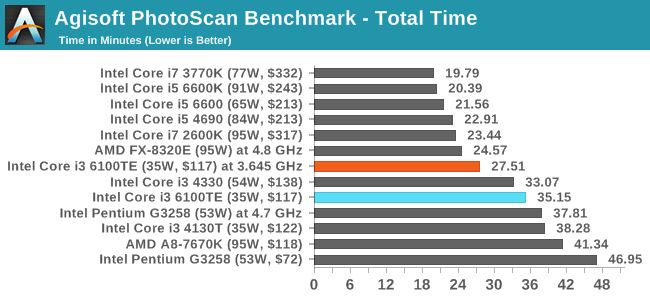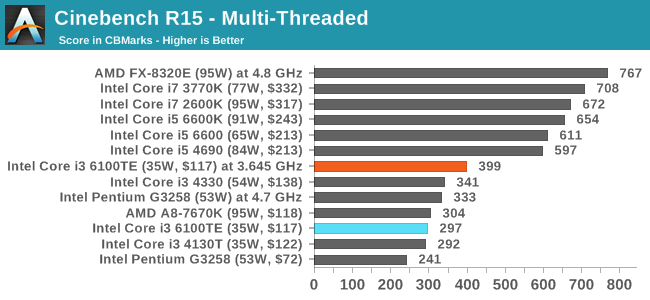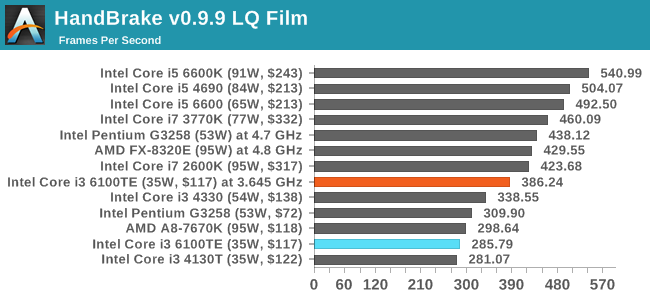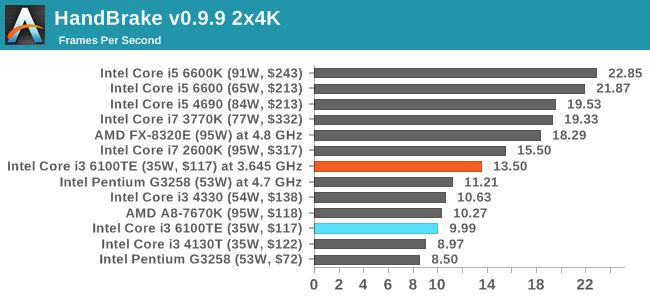Why an Overclockable Core i3 Might Not Exist: The Supermicro C7H170-M and Intel Core i3-6100TE Review
by Ian Cutress on March 17, 2016 10:30 AM EST- Posted in
- CPUs
- Intel
- Motherboards
- Core i3
- Supermicro
- Overclocking
Professional Performance: Windows
Agisoft Photoscan – 2D to 3D Image Manipulation: link
Agisoft Photoscan creates 3D models from 2D images, a process which is very computationally expensive. The algorithm is split into four distinct phases, and different phases of the model reconstruction require either fast memory, fast IPC, more cores, or even OpenCL compute devices to hand. Agisoft supplied us with a special version of the software to script the process, where we take 50 images of a stately home and convert it into a medium quality model. This benchmark typically takes around 15-20 minutes on a high end PC on the CPU alone, with GPUs reducing the time.

The variable workload of Agisoft means there are parts where the code path is single threaded and others where multithreading is near perfect. As a result we see the overclocked i3 march past almost all the AMD parts but not up to the Core i5s.
Cinebench R15
Cinebench is a benchmark based around Cinema 4D, and is fairly well known among enthusiasts for stressing the CPU for a provided workload. Results are given as a score, where higher is better.


HandBrake v0.9.9: link
For HandBrake, we take two videos (a 2h20 640x266 DVD rip and a 10min double UHD 3840x4320 animation short) and convert them to x264 format in an MP4 container. Results are given in terms of the frames per second processed, and HandBrake uses as many threads as possible.


At double 4K, Handbrake requires enough cache and buffers to keep supplying frames. The Core i3 line has a reduced L3 compared to the Core i5s, but also has to share it between threads (1.5MB/thread compared to 2MB per core) which can cause bottlenecks.










62 Comments
View All Comments
RobATiOyP - Sunday, March 20, 2016 - link
Yep.. and that's why desktop CPUs are 2 or 4 core; programs tend not to scale linearly to CPUs thanks to lock contention and Amdahl's law.When a program waits for net or disk i/o or user input, it rests in an OS wait queue, woken up when the event has completed.
rscoot - Thursday, March 17, 2016 - link
The heyday of overclocking for me was getting 50% OCs with a celeron 300A in a 440BX mobo, through mobile AMD XPs that you could push from 1.5GHz to 2.7 and beyond if you had some BH-5 and a DFI Lanparty mobo to Athlon 64s that would go from 1.8GHz to 2.7Ghz with the same RAM.BrokenCrayons - Thursday, March 17, 2016 - link
The 300A was a good time for overclocking. I never had much luck in the chip lottery with AMD CPUs. My T-birds and T-breds must have been duds, but there was a 350MHz K6-2 that I squeezed pretty hard using a peltier cooler I snagged from a computer show. Doing nothing to mitigate condensation wasn't a bright idea though. My favorite overclocked chip was a 100MHz Pentium which was getting long in tooth by the 1998. A few minutes messing with DIP switches on the motherboard got it up to 133MHz with no consideration to cooling or voltage. The heatsink was glued on by the OEM and the chip (which still exists to this day in a cardboard box) was utterly apathetic to the change.bill.rookard - Thursday, March 17, 2016 - link
It is really a shame that you pretty much do have to go back in time to get overclockable parts, but careful shopping will get you quite a lot for a little. My current build which I just put together a few weeks ago was a Xeon X3470 ($70) with an Asus P7F7-E WS motherboard. BCLK overclocking went from 2.9ghz to 4.2ghz.pizzahut22 - Thursday, March 17, 2016 - link
This article is so silly. Why did you overclock a i3 6100TE? You basically took it and made it into a standard i3 6100... Not to mention its an OEM part that nobody will be using for this.This article blows my mind. Just overclock a standard i3 6100 and give us the numbers compared to stock i5 and i7s, and overclocked i5 and i7s. Also give us some graphs about price/performance and talk about that. This article is well below typical Anandtech standards.
OrphanageExplosion - Thursday, March 17, 2016 - link
Eurogamer has all the Core i3 6100 overclocking data you need plus tons of FCAT: http://www.eurogamer.net/articles/digitalfoundry-2...In CPU-limited scenarios, an overclocked i3 with fast memory dukes it out with a Core i5 6500 with slower memory when both are paired with a Titan X (which means you're CPU-bound more of the time). I would imagine that the gap narrows if you're running something like a GTX 970.
The real question I want answered is this: if I apply a BIOS update that locks out Skylake non-K OC, do I get it back by reverting to an older BIOS?
dualsmp - Thursday, March 17, 2016 - link
I wouldn't update if you have a working overclock. I've seen a few posts about people updating their board, then reverting back to the old BIOS and it does NOT overclock anymore. It sets some kind of kill bit and overclocking does not return.OrphanageExplosion - Friday, March 18, 2016 - link
Thanks!silverblue - Friday, March 18, 2016 - link
I'd be somewhat annoyed if I'd written a 15,000 word article only to have it shot down by people who don't see my point of view, but maybe I'm not getting it.Shadowmaster625 - Thursday, March 17, 2016 - link
This has got to be some kind of joke. There is already an i3-6320 which runs at 3.9GHz. What is this review supposed to be telling us? Seems completely pointless. And then they throw in a 4.7GHz G3258 just to further highlight the pointlessness. Where is the 4.7GHz i3?